Improvement of Power Recovery by Applying a Multi-Pulse Electric Field in the Thermoelectric Cycle Power Generation Process with Pyroelectric Materials
Abstract
1. Introduction
1.1. Pyroelectric Energy Harvesting
1.2. Pyroelectric Effect
1.3. Thermoelectric Cycle for the Power Generation Process
1.4. Pulse Electric Field for Enhancing Energy Harvesting Efficiency
2. Methodology
Operational Steps in the Power Generation System according to the Thermoelectric Cycle
- Process A–B: Isothermal Step
- Process B–C: Iso-displacement Step
- Process C–E: Isothermal Step
- Process E–A: Isoelectric Step
3. Results and Discussion
3.1. Dielectric Measurements
3.2. Measurement of Sample Voltage against the Multi-Pulse Electric Field over Five Cycles
3.3. D-E Loop Measurement
3.4. Pyroelectric Energy Generation via a Multi-Pulse Electric Field
3.5. Power Generation Performance Analysis of the Pyroelectric Power Generation System under the Multi-Pulse Electric Field
- η ≤ 0: the power generation system produces no electrical power.
- 0 < η < 1: although electricity is generated, the net generating power is less than the input power supplied to the power generation system.
- η ≤ 0: the power generation system produces no electrical power.
- η = 1: the amount of input power equals the amount of net generated power.
- η > 1: the net amount of power generated is greater than the amount of power that was input.
4. Conclusions
Author Contributions
Funding
Data Availability Statement
Conflicts of Interest
References
- Pawar, O.Y.; Patil, S.L.; Redekar, R.S.; Patil, S.B.; Lim, S.; Tarwal, N.L. Strategic Development of Piezoelectric Nanogenerator and Biomedical Applications. Appl. Sci. 2023, 13, 2891. [Google Scholar] [CrossRef]
- Li, T.; Lee, P.S. Piezoelectric Energy Harvesting Technology: From Materials, Structures, to Applications. Small Struct. 2022, 3, 2100128. [Google Scholar] [CrossRef]
- Xu, Q.; Wen, J.; Qin, Y. Development and Outlook of High Output Piezoelectric Nanogenerators. Nano Energy 2021, 86, 106080. [Google Scholar] [CrossRef]
- Liang, X.; Liu, S.; Yang, H.; Jiang, T. Triboelectric Nanogenerators for Ocean Wave Energy Harvesting: Unit Integration and Network Construction. Electronics 2023, 12, 225. [Google Scholar] [CrossRef]
- Haroun, A.; Tarek, M.; Mosleh, M.; Ismail, F. Recent Progress on Triboelectric Nanogenerators for Vibration Energy Harvesting and Vibration Sensing. Nanomaterials 2022, 12, 2960. [Google Scholar] [CrossRef]
- Korkmaz, S.; Kariper, İ.A. Production and Applications of Flexible/Wearable Triboelectric Nanogenerator (TENGS). Synth. Met. 2021, 273, 116692. [Google Scholar] [CrossRef]
- Ren, Z.; Wu, L.; Zhang, J.; Wang, Y.; Wang, Y.; Li, Q.; Wang, F.; Liang, X.; Yang, R. Trapezoidal Cantilever-Structure Triboelectric Nanogenerator Integrated with a Power Management Module for Low-Frequency Vibration Energy Harvesting. ACS Appl. Mater. Interfaces 2022, 14, 5497–5505. [Google Scholar] [CrossRef]
- Korkmaz, S.; Kariper, İ.A. Pyroelectric Nanogenerators (PyNGs) in Converting Thermal Energy into Electrical Energy: Fundamentals and Current Status. Nano Energy 2021, 84, 105888. [Google Scholar] [CrossRef]
- Thakre, A.; Kumar, A.; Song, H.-C.; Jeong, D.-Y.; Ryu, J. Pyroelectric Energy Conversion and Its Applications—Flexible Energy Harvesters and Sensors. Sensors 2019, 19, 2170. [Google Scholar] [CrossRef]
- Hsiao, C.-C.; Jhang, J.-W. Pyroelectric Harvesters for Generating Cyclic Energy. Energies 2015, 8, 3489–3502. [Google Scholar] [CrossRef]
- Zhang, K.; Wang, Y.; Wang, Z.L.; Yang, Y. Standard and Figure-of-Merit for Quantifying the Performance of Pyroelectric Nanogenerators. Nano Energy 2019, 55, 534–540. [Google Scholar] [CrossRef]
- Siao, A.-S.; Hsiao, C.-C.; Chao, C.-K. Investigation and Evaluation of Pyroelectric Materials for Thermal Energy Harvesting. Phys. Status Solidi A 2019, 217, 1900716. [Google Scholar] [CrossRef]
- Olsen, R.B.; Bruno, D.A.; Briscoe, J.M. Pyroelectric Conversion Cycles. J. Appl. Phys. 1985, 58, 4709–4716. [Google Scholar] [CrossRef]
- Lee, F.Y.; Jo, H.R.; Lynch, C.S.; Pilon, L. Pyroelectric Energy Conversion Using PLZT Ceramics and the Ferroelectric–Ergodic Relaxor Phase Transition. Smart Mater. Struct. 2013, 22, 025038. [Google Scholar] [CrossRef]
- Kim, J.; Moro, T.; Kim, J.; Yamanaka, S.; Murayama, I.; Katou, T.; Nakayama, T.; Takeda, M.; Yamada, N.; Nishihata, Y.; et al. Temperature Stability of PIN-PMN-PT Ternary Ceramics during Pyroelectric Power Generation. J. Alloys Compd. 2018, 768, 22–27. [Google Scholar] [CrossRef]
- Sugiyama, H.; Kim, J.; Yamanaka, S.; Kim, Y.; Ngo, N.C.T.; Wiff, J.P.; Suzuki, T.; Baba, M.; Takeda, M.; Yamada, N.; et al. Pyroelectric Power Generation in PLZST Material by Temperature Dependent Phase Transformation. Ceram. Int. 2022, 48, 8689–8695. [Google Scholar] [CrossRef]
- Olsen, R.B.; Brown, D.D. High Efficieincy Direct Conversion of Heat to Electrical Energy-Related Pyroelectric Measurements. Ferroelectrics 1982, 40, 17–27. [Google Scholar] [CrossRef]
- Olsen, R.B.; Briscoe, J.M.; Bruno, D.A.; Butler, W.F. A Pyroelectric Energy Converter Which Employs Regeneration. Ferroelectrics 1981, 38, 975–978. [Google Scholar] [CrossRef]
- Clingman, W.H.; Moore, R.G. Application of Ferroelectricity to Energy Conversion Processes. J. Appl. Phys. 1961, 32, 675–681. [Google Scholar] [CrossRef]
- Childress, J.D. Application of a Ferroelectric Material in an Energy Conversion Device. J. Appl. Phys. 1962, 33, 1793–1798. [Google Scholar] [CrossRef]
- Hoh, S.R. Conversion of Thermal to Electrical Energy with Ferroelectric Materials. Proc. IEEE 1963, 51, 838–845. [Google Scholar] [CrossRef]
- Baba, M.; Ejima, M.; Murayama, I.; Fukuda, T.; Tanaka, H.; Sekino, T.; Kim, Y.; Yamada, N.; Takeda, M. Predicting Performance of Thermal-Electrical Cycles in Pyroelectric Power Generation. JPN J. Appl. Phys. 2020, 59, 094501. [Google Scholar] [CrossRef]
- Ngo, N.C.T.; Sugiyama, H.; Sodige, B.A.K.; Wiff, J.P.; Yamanaka, S.; Kim, Y.; Suzuki, T.; Baba, M.; Takeda, M.; Yamada, N.; et al. Sensitivity and Effectivity of Kim’s Novel Electro-Thermodynamic Cycle over Olsen Cycle on Waste Heat Recovering with High Fluctuating Temperature Source Using Lead-Free Pyroelectric Ba(Zr0.1Ti0.9)O3. AIP Adv. 2021, 11, 125310. [Google Scholar] [CrossRef]
- Meyer, V.; Sallese, J.-M.; Fazan, P.; Bard, D.; Pecheux, F. Modeling the Polarization in Ferroelectric Materials: A Novel Analytical Approach. Solid-State Electron. 2003, 47, 1479–1486. [Google Scholar] [CrossRef]
- Dawber, M.; Rabe, K.M.; Scott, J.F. Physics of Thin-Film Ferroelectric Oxides. Rev. Mod. Phys. 2005, 77, 1083–1130. [Google Scholar] [CrossRef]
- Wu, X.; Liu, L.; Li, X.; Zhao, X.; Lin, D.; Luo, H.; Huang, Y. The Influence of Defects on Ferroelectric and Pyroelectric Properties of Pb(Mg1/3Nb2/3)O3–0.28PbTiO3 Single Crystals. Mater. Chem. Phys. 2012, 132, 87–90. [Google Scholar] [CrossRef]
- Bowen, C.R.; Taylor, J.; LeBoulbar, E.; Zabek, D.; Chauhan, A.; Vaish, R. Pyroelectric Materials and Devices for Energy Harvesting Applications. Energy Environ. Sci. 2014, 7, 3836–3856. [Google Scholar] [CrossRef]
- Bei, B.-K.; Wang, H.-G.; Zhang, Z.-X. Two-Dimensional Crystallization in Finite-Sized Colloidal Systems. Acta Phys. Sin. 2019, 68, 106401. [Google Scholar] [CrossRef]
- Kim, Y.; Kim, J.; Yamanaka, S.; Nakajima, A.; Ogawa, T.; Serizawa, T.; Tanaka, H.; Baba, M.; Fukuda, T.; Yoshii, K.; et al. Novel Electrothermodynamic Power Generation. Adv. Energy Mater. 2015, 5, 1401942. [Google Scholar] [CrossRef]
- Sugiyama, H.; Kim, J.; Yamanaka, S.; Kim, Y.; Ngo, N.C.T.; Wiff, J.P.; Suzuki, T.; Baba, M.; Takeda, M.; Yamada, N.; et al. Examination of Pyroelectric Power Generation over a Wide Temperature Range by Controlling the Zr:Sn Composition Ratio of PLZST. J. Asian Ceram. Soc. 2021, 10, 99–107. [Google Scholar] [CrossRef]
- Ngo, N.C.T.; Sugiyama, H.; Sodige, B.A.K.; Wiff, J.P.; Yamanaka, S.; Kim, Y.; Suzuki, T.; Baba, M.; Takeda, M.; Yamada, N.; et al. Enhancing Low-temperature Energy Harvesting by Lead-free Ferroelectric Ba(Zr 0.1 Ti 0.9 )O 3. J. Am. Ceram. Soc. 2022, 106, 201–212. [Google Scholar] [CrossRef]
- Kim, J.; Yamanaka, S.; Nakajima, A.; Katou, T.; Kim, J.; Kim, Y.; Fukuda, T.; Yoshii, K.; Nishihata, Y.; Baba, M.; et al. Electrical and Crystallographic Study of an Electrothermodynamic Cycle for a Waste Heat Recovery. Adv. Sustain. Syst. 2018, 2, 1800067. [Google Scholar] [CrossRef]
- Ngo, N.C.T.; Sugiyama, H.; Sodige, B.A.K.; Wiff, J.P.; Furuno, H.; Yamanaka, S.; Kim, Y.; Suzuki, T.; Baba, M.; Takeda, M.; et al. Enhancing Low-Grade Waste Heat Recovery by Lead-Free Ferroelectric Ba(Zr0.1Ti0.9)O3 with Sr and Ca Isovalent Dopants. Ceram. Int. 2023, 49, 16290–16296. [Google Scholar] [CrossRef]
- He, H.; Lu, X.; Hanc, E.; Chen, C.; Zhang, H.; Lu, L. Advances in Lead-Free Pyroelectric Materials: A Comprehensive Review. J. Mater. Chem. C 2020, 8, 1494–1516. [Google Scholar] [CrossRef]
- Kishore, R.; Priya, S. A Review on Low-Grade Thermal Energy Harvesting: Materials, Methods and Devices. Materials 2018, 11, 1433. [Google Scholar] [CrossRef]
- Poprawski, W.; Gnutek, Z.; Radojewski, J.; Poprawski, R. Pyroelectric and Dielectric Energy Conversion—A New View of the Old Problem. Appl. Therm. Eng. 2015, 90, 858–868. [Google Scholar] [CrossRef]
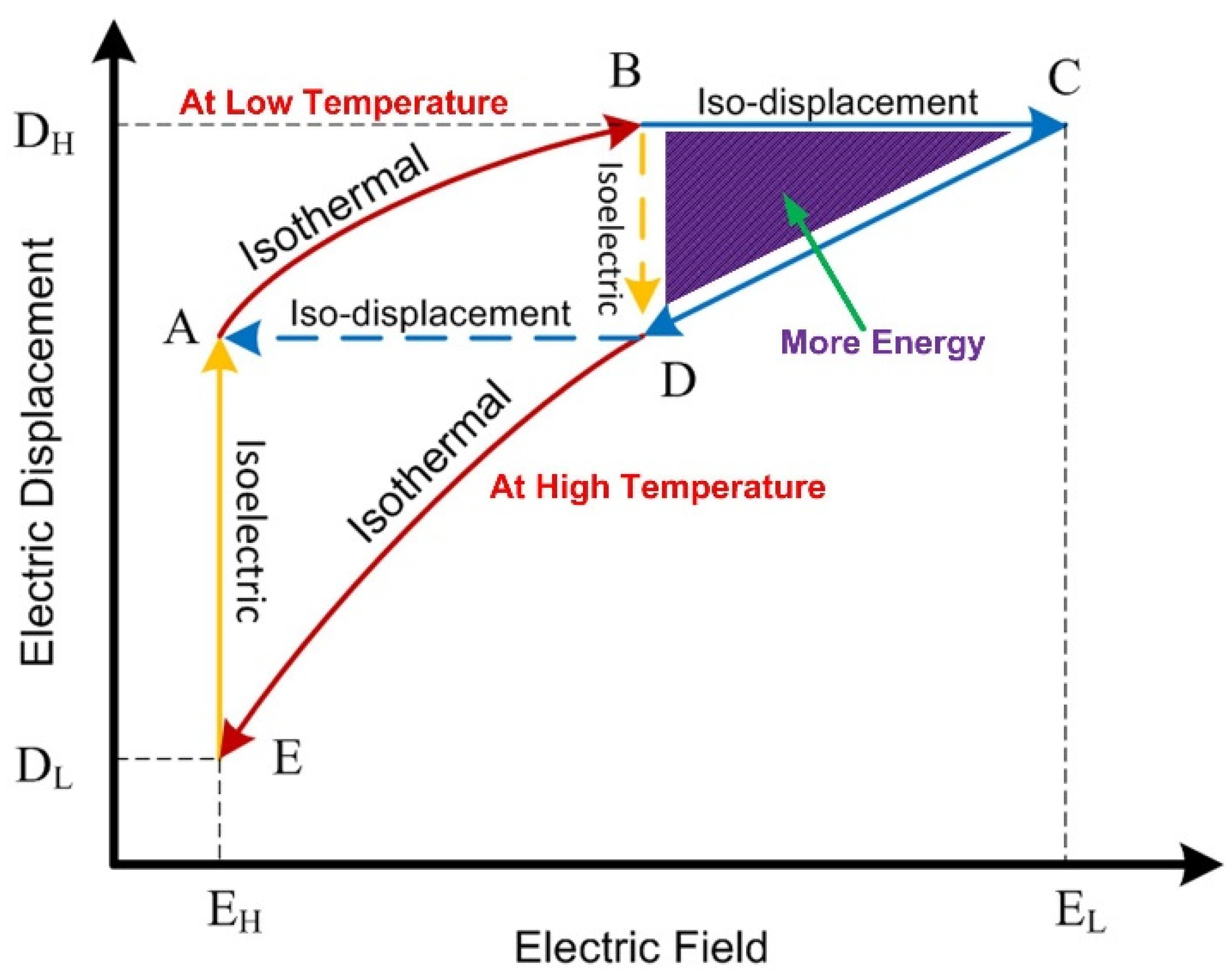

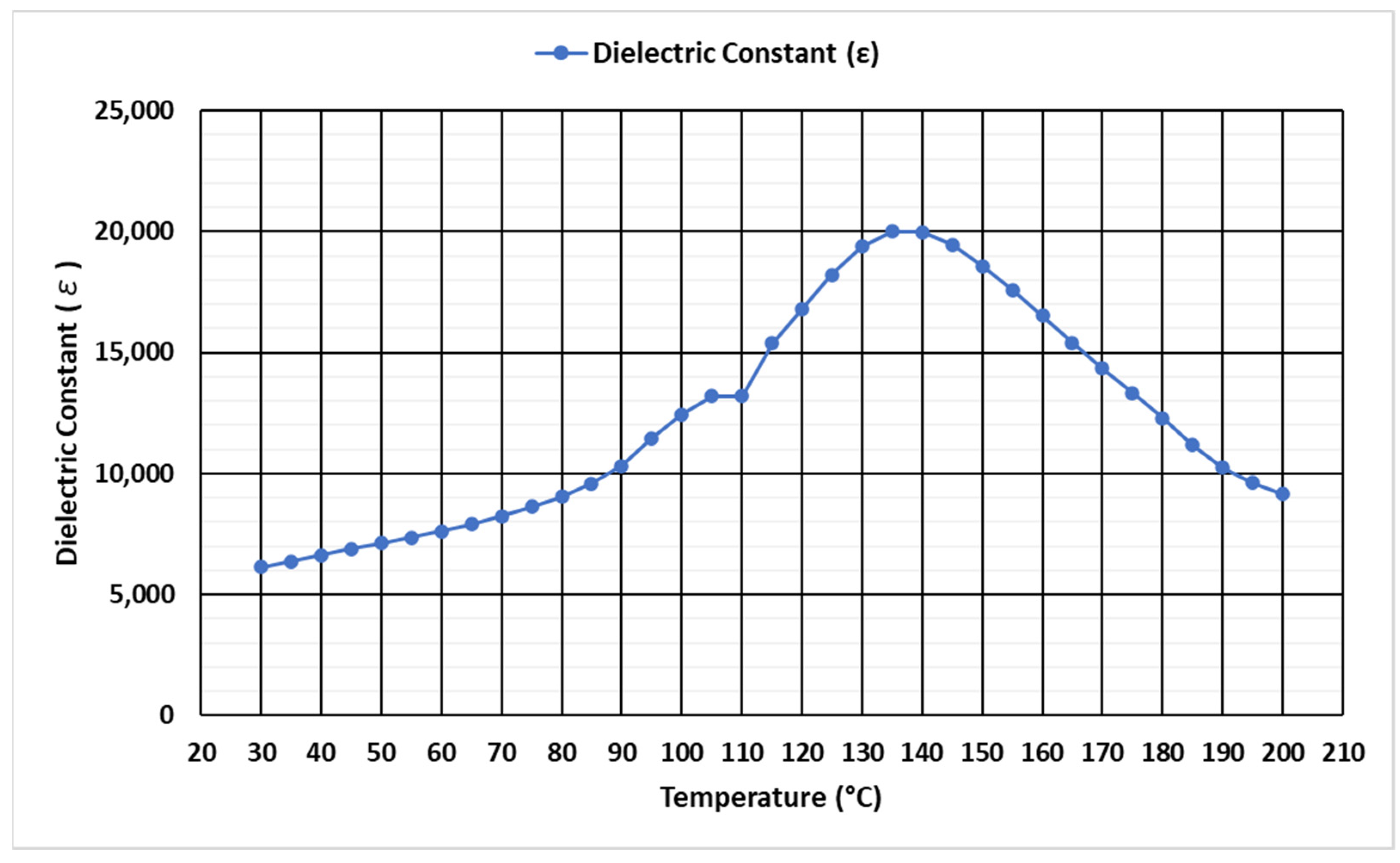
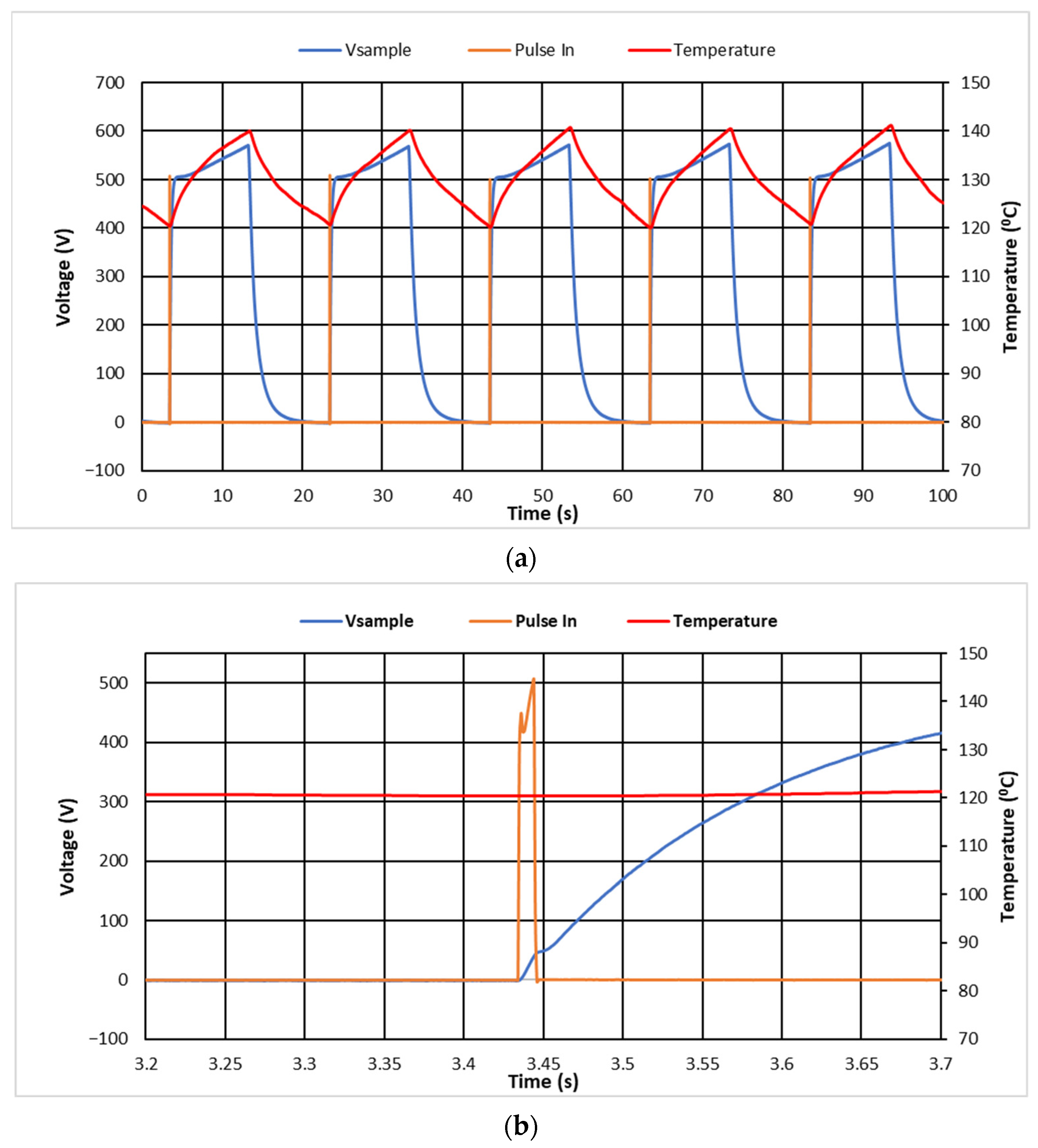



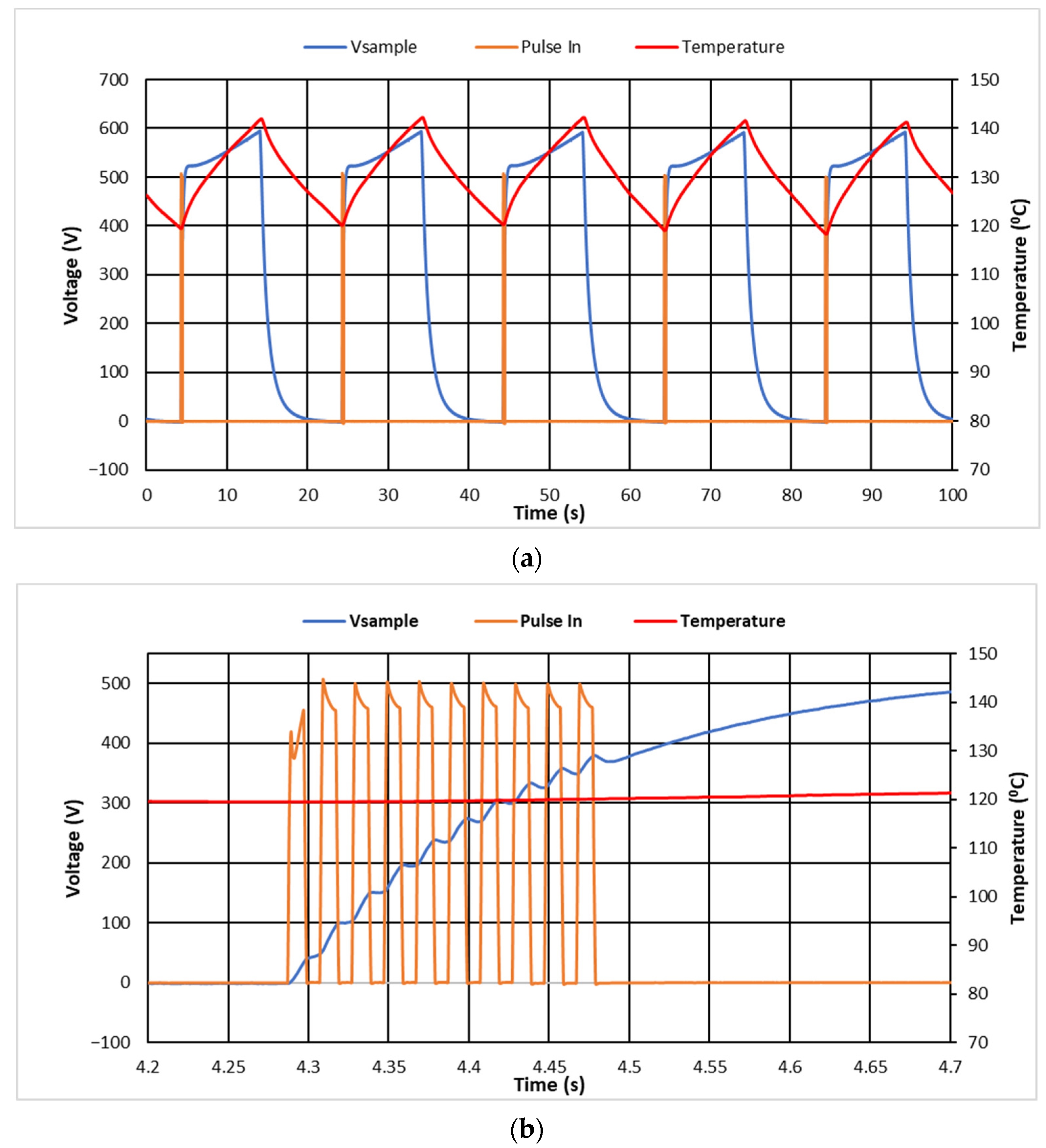
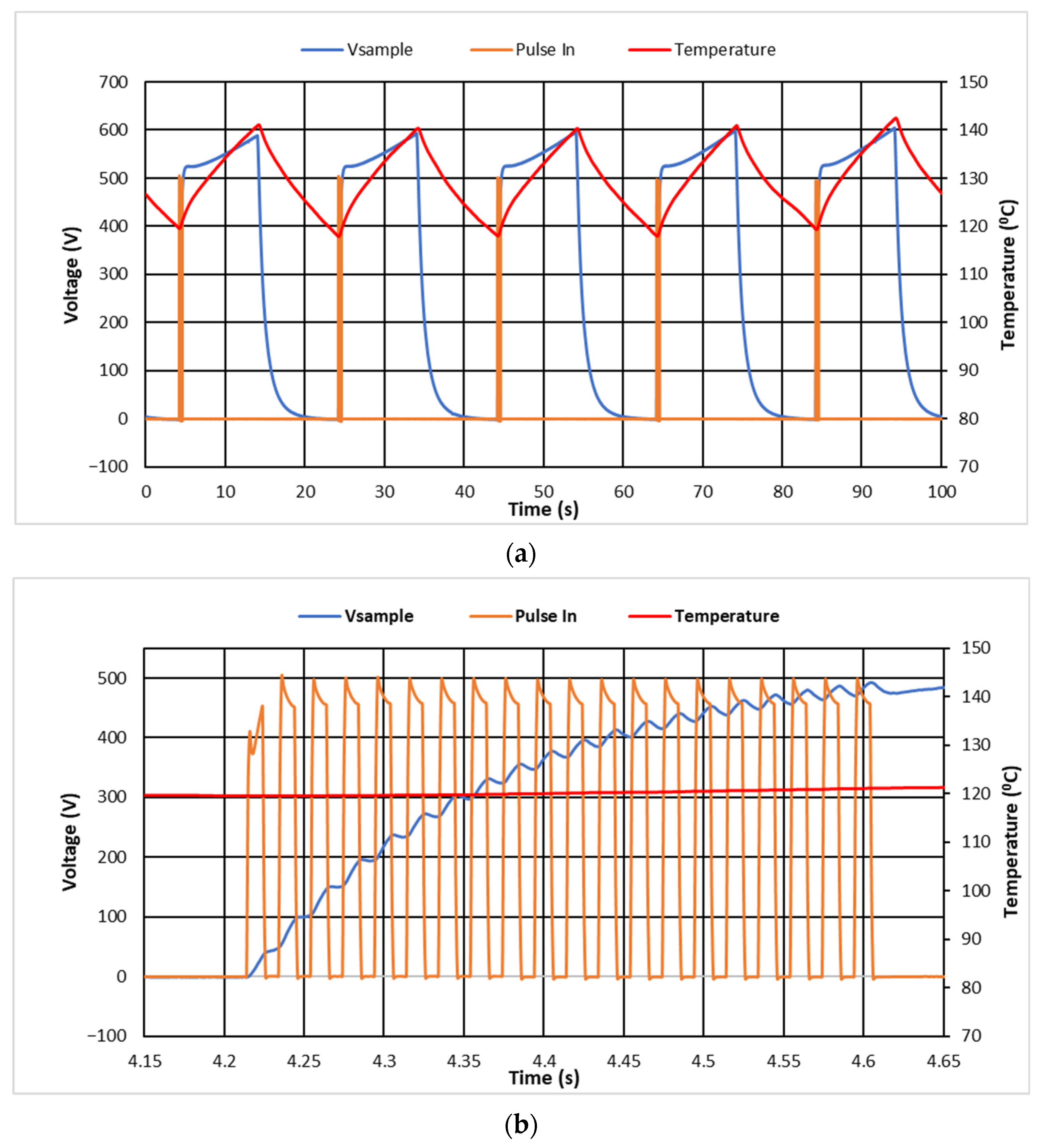
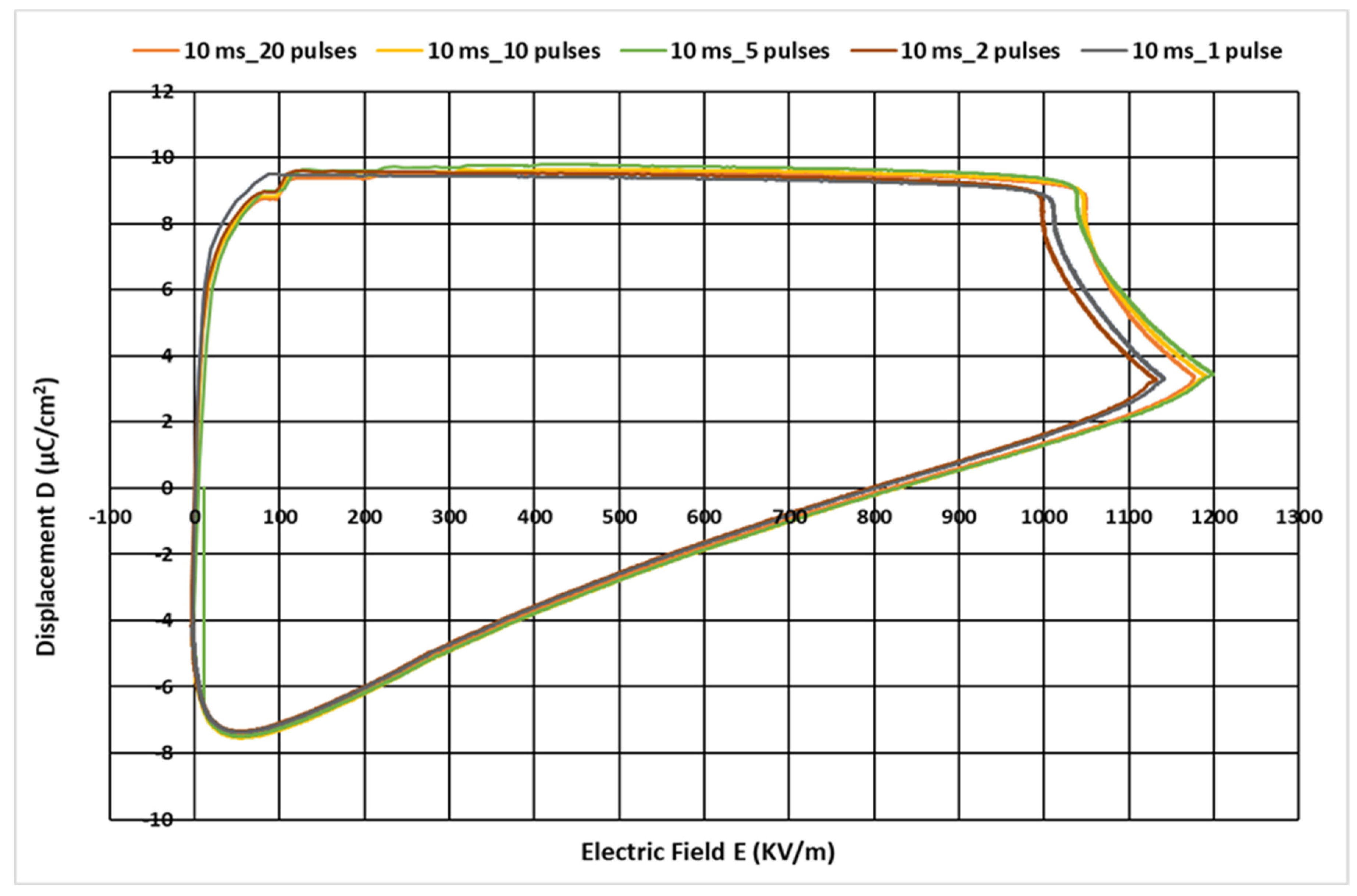

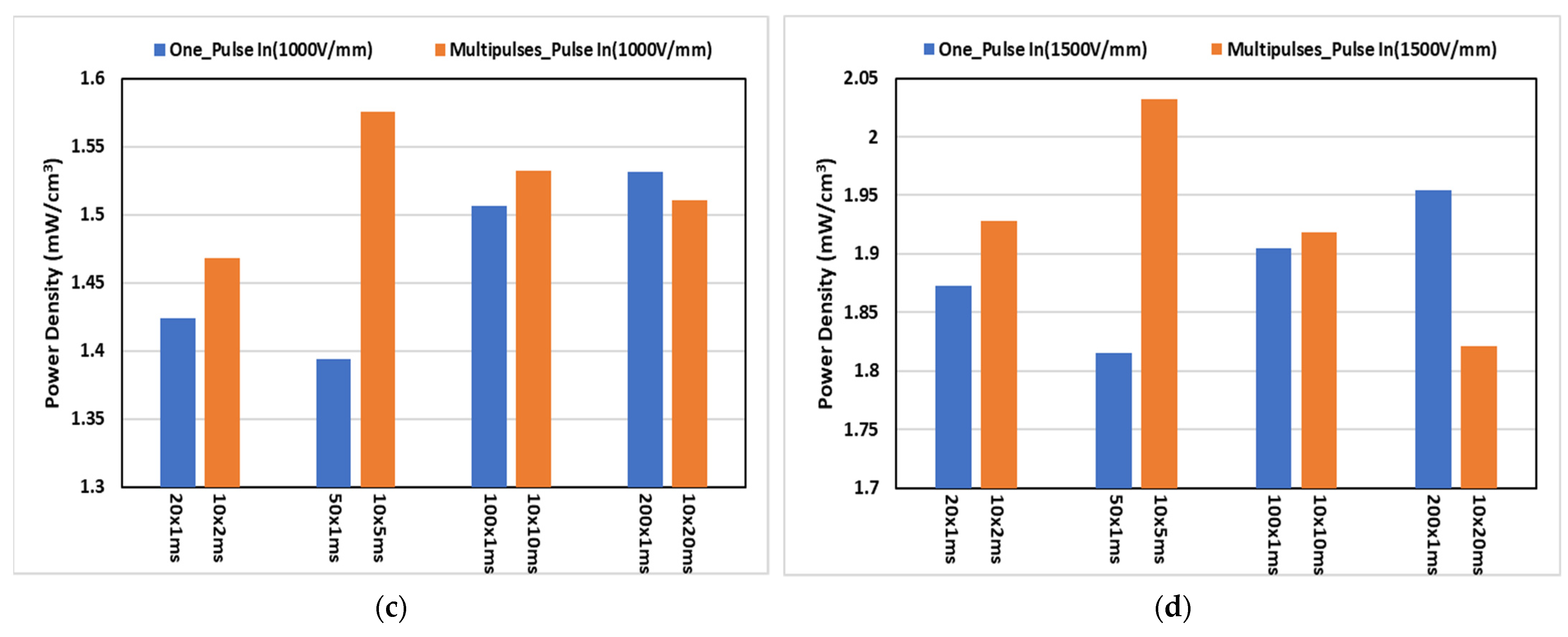

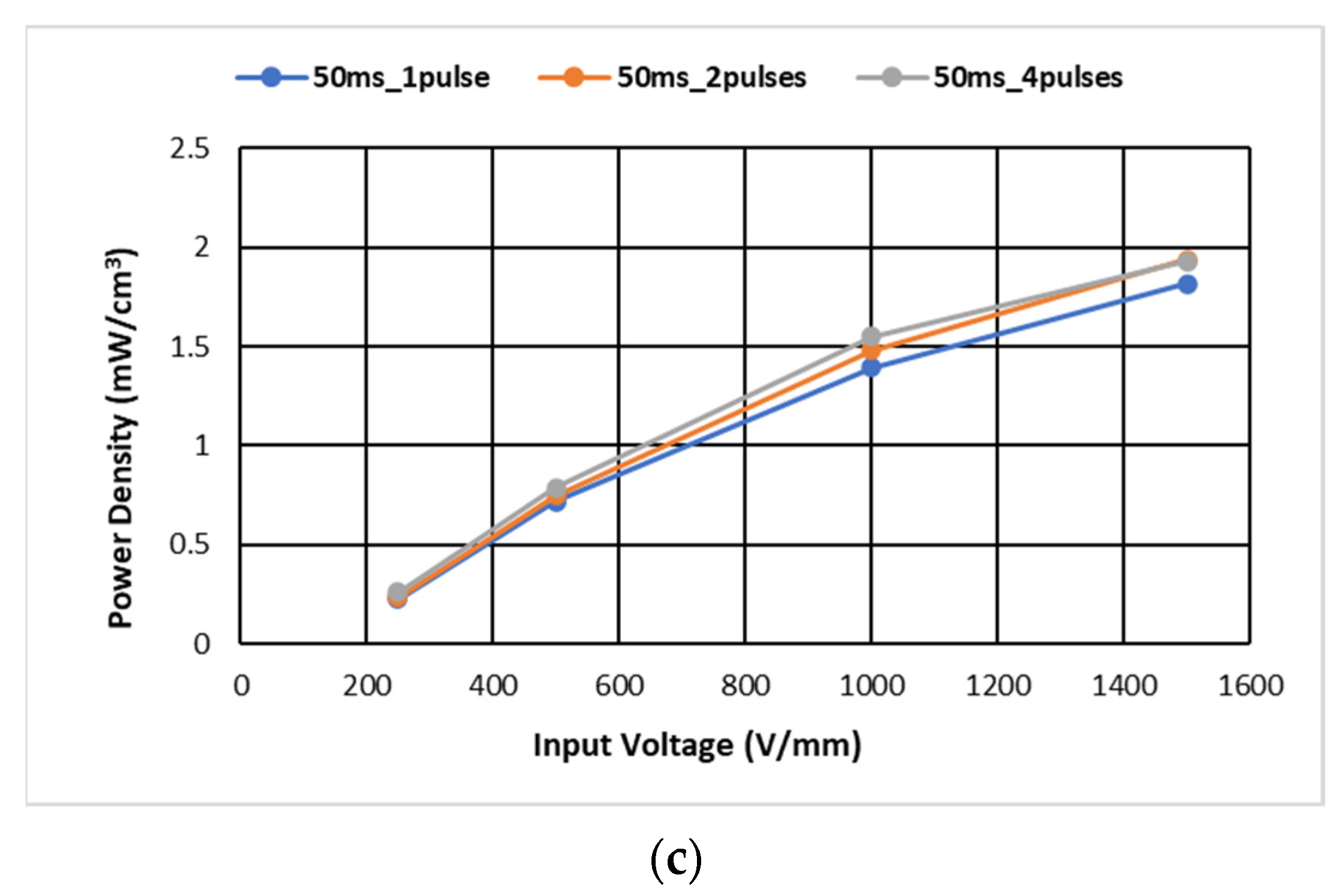



| Operation Process | Switching Status | ||
|---|---|---|---|
| SW1 | SW2 | SW3 | |
| Isothermal | ON | OFF | OFF |
| Iso-displacement | OFF | OFF | OFF |
| Isothermal | OFF | ON | ON |
| Isoelectric | OFF | ON | ON |
| Number of Pulses for 10 ms Pulse Width | Pulse Input (V) | Maximum Sample Voltage (V) |
|---|---|---|
| 1 | 503 | 570 |
| 2 | 503 | 570 |
| 5 | 502 | 595 |
| 10 | 502 | 595 |
| 20 | 502 | 595 |
Disclaimer/Publisher’s Note: The statements, opinions and data contained in all publications are solely those of the individual author(s) and contributor(s) and not of MDPI and/or the editor(s). MDPI and/or the editor(s) disclaim responsibility for any injury to people or property resulting from any ideas, methods, instructions or products referred to in the content. |
© 2023 by the authors. Licensee MDPI, Basel, Switzerland. This article is an open access article distributed under the terms and conditions of the Creative Commons Attribution (CC BY) license (https://creativecommons.org/licenses/by/4.0/).
Share and Cite
Sodige, B.A.K.; Furuno, H.; Ngo, N.C.T.; Sugiyama, H.; Baba, M.; Niihara, K.; Nakayama, T. Improvement of Power Recovery by Applying a Multi-Pulse Electric Field in the Thermoelectric Cycle Power Generation Process with Pyroelectric Materials. Energies 2023, 16, 4728. https://doi.org/10.3390/en16124728
Sodige BAK, Furuno H, Ngo NCT, Sugiyama H, Baba M, Niihara K, Nakayama T. Improvement of Power Recovery by Applying a Multi-Pulse Electric Field in the Thermoelectric Cycle Power Generation Process with Pyroelectric Materials. Energies. 2023; 16(12):4728. https://doi.org/10.3390/en16124728
Chicago/Turabian StyleSodige, Buddhika Amila Kumara, Hideto Furuno, Nguyen Chi Trung Ngo, Hironari Sugiyama, Masaaki Baba, Koichi Niihara, and Tadachika Nakayama. 2023. "Improvement of Power Recovery by Applying a Multi-Pulse Electric Field in the Thermoelectric Cycle Power Generation Process with Pyroelectric Materials" Energies 16, no. 12: 4728. https://doi.org/10.3390/en16124728
APA StyleSodige, B. A. K., Furuno, H., Ngo, N. C. T., Sugiyama, H., Baba, M., Niihara, K., & Nakayama, T. (2023). Improvement of Power Recovery by Applying a Multi-Pulse Electric Field in the Thermoelectric Cycle Power Generation Process with Pyroelectric Materials. Energies, 16(12), 4728. https://doi.org/10.3390/en16124728






